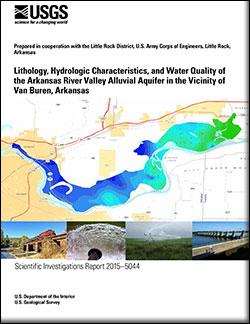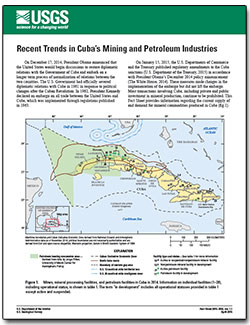Filters: Types: OGC WMS Layer (X) > Types: Citation (X) > Types: OGC WMS Service (X)
818 results (73ms)|
Filters
Date Range
Extensions Types
Contacts
Categories Tag Types
|
Habitat fragmentation and flow regulation are significant factors related to the decline and extinction of freshwater biota. Pelagic-broadcast spawning cyprinids require moving water and some length of unfragmented stream to complete their life cycle. However, it is unknown how discharge and habitat features interact at multiple spatial scales to alter the transport of semi-buoyant fish eggs. Our objective was to assess the relationship between downstream drift of semi-buoyant egg surrogates (gellan beads) and discharge and habitat complexity. We quantified transport time of a known quantity of beads using 2–3 sampling devices at each of seven locations on the North Canadian and Canadian rivers. Transport time was...
We used the United States National Grid to develop a sampling grid for monitoring programs in the Great Plains Landscape Conservation Cooperative, delineated by Bird Conservation Regions 18 and 19. Landscape Conservation Cooperatives are science based partnerships with the goal to inform and guide conservation at regional landscape levels. Developing a standardized sampling grid for a LCC is a new endeavor and is designed to reduce program costs, avoid repetition in sampling, and increase efficiency in monitoring programs. This is possible because the grid’s nationwide coverage, uniform starting point, and scalability allow researchers to expand their monitoring programs from a small, local level to a regional or...
Categories: Data,
Publication;
Types: Citation,
Map Service,
OGC WFS Layer,
OGC WMS Layer,
OGC WMS Service;
Tags: BIRDS,
Colorado,
Colorado,
Federal resource managers,
Final Report,
From 2013 to 2015, bathymetric surveys of New York City’s six West of Hudson reservoirs (Ashokan, Cannonsville, Neversink, Pepacton, Rondout, and Schoharie) were performed to provide updated capacity tables and bathymetric maps. Depths were surveyed with a single-beam echo sounder and real-time kinematic global positioning system (RTK-GPS) along planned transects at predetermined intervals for each reservoir. A separate set of echo sounder data was collected along transects at oblique angles to the main transects for accuracy assessment. Field survey data was combined with water-surface elevations in a geographic information system to create three-dimensional surfaces representing reservoir-bed elevations in the...
Physical and chemical changes affect the biota within urban streams at varying scales ranging from individual organisms to populations and communities creating complex interactions that present challenges for characterizing and monitoring the impact on species utilizing these freshwater habitats. Salmonids, specifically cutthroat trout (Oncorhynchus clarkii) and coho salmon (Oncorhynchus kisutch), extensively utilize small stream habitats influenced by a changing urban landscape. This study used a comprehensive fish health assessment concurrent with the U.S. Geological Survey’s Pacific Northwest Stream Quality Assessment in 2015 to quantifiy impacts from disease in juvenile coho and cutthroat salmon, impacts to...
Categories: Data;
Types: Citation,
Map Service,
OGC WFS Layer,
OGC WMS Layer,
OGC WMS Service;
Tags: Aquatic Biology,
Bioenergtics,
Church Creek,
Coulter Creek,
East Fork Dairy Cree,
The Hudson Shelf Valley is the submerged seaward extension of the ancestral Hudson River drainage system and is the largest physiographic feature on the Middle Atlantic continental shelf. The valley begins offshore of New York and New Jersey at about 30-meter (m) water depth, runs southerly and then southeasterly across the Continental Shelf, and terminates on the outer shelf at about 85-m water depth landward of the head of the Hudson Canyon. Portions of the 150-kilometer-long valley were surveyed in 1996, 1998, and 2000 using a Simrad EM1000 multibeam echosounder mounted on the Canadian Coast Guard ship Frederick G. Creed. The purpose of the multibeam echosounder surveys was to map the bathymetry and backscatter...
Boiling River at Mammoth (YBOI), Yellowstone National Park Sample Collection: Samples were collected near the USGS stream gage 06190540 (Latitude 44°59'05.83", Longitude 110°41'18.20" NAD83). At the time of collection, all waters samples were filtered through a syringe filter (0.45-micrometer). Two splits of the filtered water were retained for chemical analyses, including an unacidified (FU) sample for determination of anion concentrations and a nitric acid preserved (FA; 1% volume-to-volume concentrated trace-metal grade nitric acid) sample for cation and trace metal analyses. During sample collection, the water temperature, specific conductance, and pH were often measured. Sample Analyses: Concentrations...
Categories: Data;
Types: Citation,
Map Service,
OGC WFS Layer,
OGC WMS Layer,
OGC WMS Service;
Tags: Boiling River,
Geothermal,
Yellowstone National Park,
chloride flux
Falls River near Squirrel, Idaho (YFAL) Sample Collection: Samples were collected near the USGS stream gage 13046995 (Latitude 44°03'43", Longitude 111°09'07" NAD83). At the time of collection, all waters samples were filtered through a syringe filter (0.45-micrometer). Two splits of the filtered water were retained for chemical analyses, including an unacidified (FU) sample for determination of anion concentrations and a nitric acid preserved (FA; 1% volume-to-volume concentrated trace-metal grade nitric acid) sample for cation and trace metal analyses. During sample collection, the water temperature, specific conductance, and pH were often measured. Sample Analyses: Concentrations of chloride, fluoride,...
Categories: Data;
Types: Citation,
Map Service,
OGC WFS Layer,
OGC WMS Layer,
OGC WMS Service;
Tags: Geothermal,
Yellowstone National Park,
chloride flux
Water surface elevations within seven Willamette River off-channel features (OCF; alcoves and side channels) were measured using submerged pressure transducers. Transducers were installed from late May through mid-October, 2016, when discharge of the Willamette River was between approximately 5,500 and 45,000 cubic feet per second at Salem, Oregon (USGS gage 14191000) and 3,500 to 17,500 cubic feet per second at Harrisburg, Oregon (USGS gage 14166000). Pressure transducer sensor depth was measured at all seven sites. For five of the sites, pressure transducer sensor depths were converted to water surface elevations by surveying the water surface at each transducer with a real-time kinematic global positioning system...
Categories: Data;
Types: Citation,
Map Service,
OGC WFS Layer,
OGC WMS Layer,
OGC WMS Service;
Tags: Ecology,
Geomorphology,
Oregon,
RTK,
USGS Science Data Catalog (SDC),
This dataset contains reflectance and transmission spectra of unexpanded and expanded vermiculite ore, and handpicked flakes of phlogopite, hydrobiotite, and vermiculite. These samples were collected from mines near Enoree, South Carolina; Libby, Montana; Louisa, Virginia; Palabora, Llano, Texas; and South Africa. Spectra are identified as either reflectance or transmission in the alphanumeric file names and correlate to specpr record numbers designated in the manuscript figures in which they are shown. These transmission spectra were converted to absorbance in many of the figures. Spectra of talc, fibrous richterite amphibole, and serpentine are from well characterized samples from Feiser Mine, Ruby Mountains,...
This dataset consists of 102 magnetotelluric (MT) stations collected in 2012-2014 in the Rio Grande Rift and southern Rocky Mountains. The U.S. Geological Survey acquired these data to improve regional conductivity models of the western United States. This work is in support of studies of the effect of lithospheric modification on electrical resistivity structure and tectonic evolution of the western United States.
Categories: Data;
Types: Citation,
Map Service,
OGC WFS Layer,
OGC WMS Layer,
OGC WMS Service;
Tags: Carson National Forest,
Colfax County,
Colorado,
Colorado Plateau,
Dona Ana County,
Surveys of the bathymetry and backscatter intensity of the sea floor south of Long Island, New York, were carried out in November 1998 using a Simrad EM1000 multibeam echosounder mounted on the Canadian Coast Guard ship Frederick G. Creed. The purpose of the multibeam echosounder surveys was to explore the bathymetry and backscatter intensity of the sea floor in several areas off the southern coast of Long Island along the 20-meter isobath. Survey areas offshore of Fire Island Inlet, Moriches Inlet, Shinnecock Inlet, and southwest of Montauk Point were about 1 kilometer (km) wide and 10 km long. The area was mapped by the U.S. Geological Survey with support from the Canadian Hydrographic Service and the University...
Abstract The isotopic composition of Pb in fugitive dust suspended by a vehicle from 13 unsurfaced roads in Missouri was measured to identify the source of Pb within an established long-term mining area. A three end member model using 207Pb/206Pb and concentration as tracers resulted in fugitive dust samples plotting in the mixing field of well characterized heterogeneous end members. End members selected for this investigation include the 207Pb/206Pb for 1) a Pb-mixture representing mine tailings, 2) aerosol Pb impacted soils within close proximity to the Buick secondary recycling smelter, and 3) an average of soils, rock cores and drill cuttings representing the background characteristics. Aqua regia total concentrations...
This dataset contains images obtained from unmanned aerial systems (UAS) flown in the Cape Cod National Seashore. The objective of the field work was to evaluate the quality and cost of mapping from UAS images. Low-altitude (approximately 120 meters above ground level) digital images were obtained from cameras in a fixed-wing unmanned aerial vehicle (UAV) flown from the lawn adjacent to the Coast Guard Beach parking lot on 1 March, 2016. The UAV was a Skywalker X8 flying wing operated by Raptor Maps, Inc., contractors to the U.S. Geological Survey. U.S. Geological Survey technicians deployed and mapped 28 targets that appear in some of the images for use as ground control points. All activities were conducted according...
Publications that have used data collected during the Spoon-billed Sandpiper surveys.
Categories: Data,
Publication;
Types: Citation,
Map Service,
OGC WFS Layer,
OGC WMS Layer,
OGC WMS Service;
Tags: ANIMALS/VERTEBRATES,
Arctic,
BIOLOGICAL CLASSIFICATION,
BIRDS,
EARTH SCIENCE,
The data set contains results for nine serum biochemistries in molting Pacific black brant (Branta bernicla nigricans). These data were used to calculate reference intervals (sometimes referred to as normal values) for the nine serum biochemistries. All brant were after-hatch year. All samples were collected in 2006 and 2007 in the Teshekpuk Lake Special Area, Alaska.
Categories: Data;
Types: Citation,
Map Service,
OGC WFS Layer,
OGC WMS Layer,
OGC WMS Service;
Tags: Alaska,
Arctic Coastal Plain,
Serum biochemistry,
Teshekpuk Lake Special Area,
USGS Science Data Catalog (SDC)
These datasets (S2-S3) document the transmission of a bacterial pathogen (Mycoplasma agassizii) between desert tortoises (Gopherus agassizii) experimentally introduced in captivity and were used to create and compare models predicting transmission probability given data on the hosts and their interactions. Dataset S2 includes variables describing the individual tortoises interacting, e.g. id, sex; variables describing the length of their interaction, e.g., number of days cohabitating, hours of direct contact; and variables estimating the infection level (based on data in S3) of infected tortoises involved in the interaction with the focal host.Interaction time and the amount of bacteria present in an infected host...
Parameter values for the Precipitation Runoff Modeling System (PRMS) using the National Hydrologic Modeling (NHM) infrastructure. The contents of the attached zip folder are a direct download from the USGS bitbucket repository titled National Hydrologic Model Parameter Database (NhmParamDb) (https://my.usgs.gov/bitbucket/projects/MOWS/repos/nhmparamdb/browse). The NhmParamDb is stored using a Git version control system, which tracks modifications to the master dataset through 'commits'. Each commit has a unique code to allow for retroactive identification of any given component of the repository. The specific attributes of the download contained in this release are: Date: May 8, 2017 Commit: 6ccc41d5688 Filename:...
In 2012, the U.S. Geological Survey (USGS) in cooperation with Colorado Springs Utilities selected 10 reaches or study areas along Fountain Creek between Colorado Springs and the confluence of Fountain Creek at the Arkansas River for annual bed and bank characterization and topographic surveys. The 10 selected study areas are approximately 5 to 20 bank-full channel widths in length. The topographic surveys collected point data of location and elevation in the active channel and along both left and right banks and flood plains. Starting in 2012, USGS personnel have collected topographic survey data annually during the winter, spring, or summer using real-time kinematic Global Navigation Satellite Systems. These point...
Types: Citation,
Map Service,
OGC WFS Layer,
OGC WMS Layer,
OGC WMS Service;
Tags: Colorado,
Colorado Springs,
El Paso County,
Fountain,
Fountain Creek,

Categories: Publication;
Types: Citation,
Map Service,
OGC WFS Layer,
OGC WMS Layer,
OGC WMS Service;
Tags: Scientific Investigations Report

Categories: Publication;
Types: Citation,
Map Service,
OGC WFS Layer,
OGC WMS Layer,
OGC WMS Service;
Tags: Fact Sheet
|

|